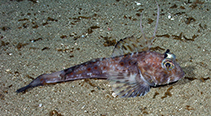| Family: |
Cottidae (Sculpins) |
| Max. size: |
27 cm TL (male/unsexed) |
| Environment: |
demersal; marine; depth range 18 - 800 m |
| Distribution: |
Eastern Pacific: Chirikof Island in the western Gulf of Alaska to Point Loma and Cortez Bank, southern California, USA. |
| Diagnosis: |
Dorsal spines (total): 9-11; Dorsal soft rays (total): 15-18; Anal spines: 0-0; Anal soft rays: 13-15. Caudal fin fanned out, bluntly rounded; pelvic fins small, extending about one-third distance to anal origin (Ref. 6885). Color olive green to light brown on dorsal surface, creamy yellow to light brown on ventral surface, 4 dark saddles across back, bars of dark blotches on all fins except pelvic and anal fins; sometimes dusky along margin of anal fin; males sometimes variously blotched with orange to red; silvery areas anterior to and behind base of pectorals (Ref. 6885). |
| Biology: |
Commonly found on sand and mud bottoms (Ref. 2850). Feeds on crustaceans, including shrimps and isopods (Ref. 6885). |
| IUCN Red List Status: |
Least Concern (LC); Date assessed: 04 February 2009 Ref. (130435)
|
| Threat to humans: |
harmless |
Source and more info: www.fishbase.org. For personal, classroom, and other internal use only. Not for publication.
